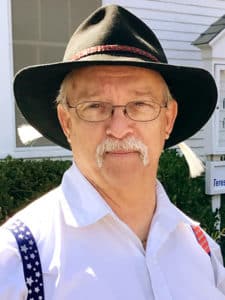Steven Spencer may be the director of construction for a major fast-fashion retailer, but he’s also happy to talk about horses. In fact, he’s used to it.

When a second collarbone injury ended his ten-year stint as a professional jockey back in 1985, he pivoted toward a career in construction management and corporate leadership, starting off as an estimator. “My resume said ‘jockey, thoroughbred nationwide,’” he recalls. “I got a lot of interviews, but they just wanted to talk to me about horse racing.”
One particular race he remembers well occurred in Atlantic City in 1975, back when he was still a “bugboy.” In the 1880s, apprentice riders were denoted by an asterisk next to their name in the program. Spectators often thought the typographical symbol was actually a squashed insect—hence the nickname.
As Spencer explains, it’s extremely difficult for bugboys to see when they’re racing. Novices tend to get a kind of tunnel vision when they ride, which got especially bad for him during the 1975 race when it began pouring rain. Although he thought he was in dead last (not to mention temporarily blind), Spencer decided to finish out the race.
“I’m riding and riding, and I can hear the crowd,” he says. “They’re really loud, so I’m thinking this really must be an exciting race.”
Once he passed the finished line and kept riding, an outrider flagged him down. It turned out he had won. “Because my horse came from behind, he became stronger and stronger as he rode down the stretch,” Spencer says. “While I was blind, the horse was smart enough to weave through traffic and win the race. But I didn’t know what was happening. I had won by a head or something.”
Today, working for the retailer, Spencer has long moved on from being a professional jockey. But, that doesn’t mean the two halves of his career aren’t connected. He sees his approach to horse-racing as a direct metaphor for his construction management and corporate leadership, and here he elaborates on the link between his past and present occupations
So, who finally asked you about something other than horse racing in a job interview?
Sheldon Friedman of ComCal Construction. He built the first Red Robin. He built the first Mrs. Fields’ Original Cookies. I worked for him for five years. The education was amazing. I didn’t know about the AIA/CSI numbering system. He laughed and spent the next hour explaining it to me. One day, I asked, “What’s a PSI?” He said to his wife, “Anne Rita, go get coffee and sandwiches,” then spent the next three hours explaining concrete to me—its use and its mixes and the proper amounts of rebar and water. Most importantly, whenever we looked at a problem, he looked at it from a real estate point of view, an architecture point of view, and a construction point of view.
And now your career has come full-circle. You’re talking about writing a book that relates horse racing to business.
I don’t know if it will ever get written. I’m a terrible writer. You’ve got to know your strengths and weaknesses. Regardless, most horse analogies are just life lessons. You take the life lessons you’ve learned, and you show people how you can apply them to business. It’s somebody sharing a different perspective. NFL players give a lot of business people great insights into how they’ve gotten to the top of their game. No one’s done it with horse racing that I know of, so I’d love to share some of those stories with people.
How does it specifically relate to construction management?
It’s more about being the owner—how to make better contractors, better architects, better subcontractors, better teammates. Sometimes owners forget that they’re trying to get their contractors to succeed. If they make money, that’s a good thing because you’ve already agreed on the price. You want them to make money; you want them to be successful—just like you want the horse to be successful. You want the horse to win.
What are some other useful metaphors to keep in mind?
A jockey’s purpose is to bring out the best in the horse every time the gate opens. Corporate leadership is no different. You have to generate trust and confidence in your people as well as the drive to win every day. A jockey really only has a few minutes to gain the horse’s trust.
So you’re not riding the same horse throughout your entire career? It’s not like Seabiscuit?
Not at all. I rode thousands of horses throughout my career—quarter horses, appaloosas, thoroughbreds. I once even did a jiggy-jog/trotter race for charity.
You may find a horse that’s a good fit and that the trainer and owner want you to ride. But even that may be only four, five, six times in a year. Usually, though, you’re riding eight to ten races a day, five or six days a week. Many times, I walked into a paddock, and my agent put me on a horse that I’d never even seen before.
It’s about gaining respect, trust, and communication with the animal. You need to develop that rapport really quickly because you’re going to go into harm’s way with that horse. My dad once said, “You can’t make them run any faster, but you can slow them down.” That’s what owners do sometimes. They get a really good contractor, and they slow them down. I try to avoid that and make sure I’m supporting the contractor to get their job done. As with horse racing, a light touch is always better than manhandling the situation.
Armed with so many horse-racing analogies, what was it like joining a major retailer in 2016? What did you set out to change?
They had very few bidders. They had been using the same four to six contractors for the last fifteen years and wanted to make a change because the costs were getting higher and higher. That was different for me. In England, they ride clockwise. Here in America, we ride counter-clockwise. You’re still horse racing.
So, I wanted to rotate who it is that gets to bid. One of the things I’ve learned through the years is that I don’t want to go back and forth. In retail, you just don’t have time to negotiate the job after you bid.
I told all the contractors, “When you’re working with me, you can’t lower your bid once you’ve turned a bid in. If you’ve made a mistake, you can raise it. But you can’t lower your bid. So bid accordingly.”
It worked. I lowered the prices here domestically by 35 percent and internationally by 40 percent. I tell contractors, “It’s competitive; it’s not adversarial.” I send them the contract 24 hours after they bid it. I cannot remember the last time I missed a store opening or turnover date.


